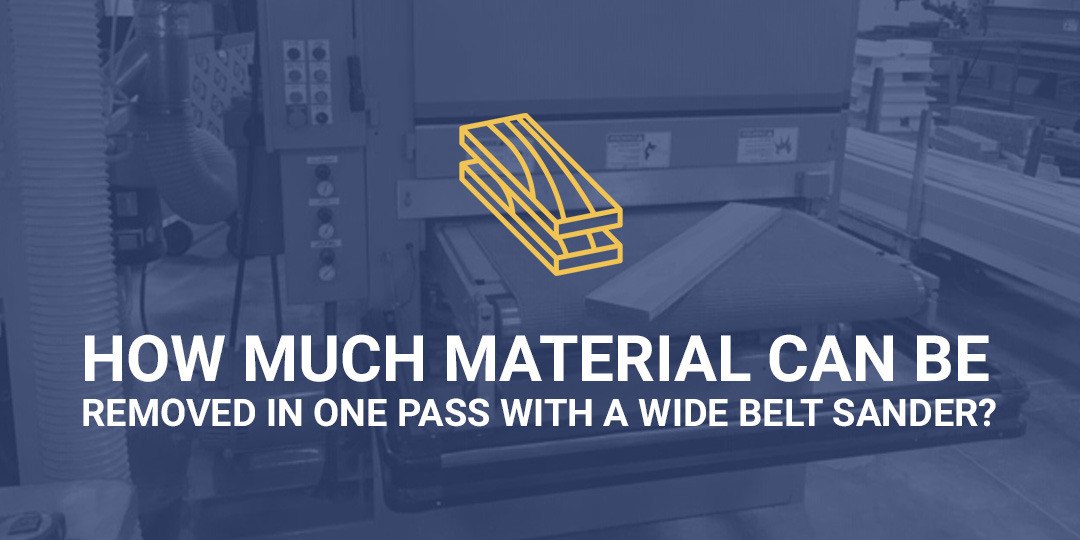
Woodworking companies commonly use wide belt sanders to sand down wooden items to a specified finish and thickness. You can create even surfaces for solid wood materials and composite materials such as plywood, sand down rough surfaces, and prepare wood for special coatings. You can even use a wide belt sander to remove unwanted residue like built-up paint and varnish from your material.
Most wide belt sanders have the same operation. The height-adjustable table should be raised so the space between the belt and the table is slightly less than the thickness of the wood you're sanding. As you feed the wood through the machine, the abrasive belt sands it down to the desired thickness.
Since efficiency is a key goal for any woodworking shop or production line, you’ll want to know how much material you can remove in one pass with a wide belt sander. There’s no single answer that applies to all machines and configurations, so in this blog, we’ll review the factors that impact material removal.
Abrasive Type
On a wide belt sander, stock removal is determined more by the belt than by the machine. An abrasive belt is designed to remove a certain amount of stock, and if that amount is exceeded, the belt's working life will be reduced.
For heavy stock removal, you should generally use lower grit belts- belts with 36-80 grit abrasives will remove ⅛” to 1/32” respectively. Belts with a medium grit (100 to 120) can remove around 1/32” to 1/64” in a single pass. Any abrasive with a grit of 150 or more should be used for finishing instead of material removal.
Type of Sanding Head
The type of sanding head you should use depends on the results you require (stock removal vs. end finish). If you cannot make multiple passes due to your production schedule, a machine with two or three heads may give you the finished look you need in one pass, rather than two or three.
As mentioned earlier, the amount of stock an abrasive can remove is dependent on grit size. A three-head sander can enable you to run a grit sequence of around 100-150-180 and eliminate around 1/32” of material in one pass.
If you want to calculate how many heads you need, you need to know how much stock you need to remove and what your final grit finish is. You then work backward to find out how many heads are required for the finished result. (Don't skip more than one grit size in a sequence).
Abrasive Belt Speed
Running the wide belt sander at the right speed is as important as choosing the right abrasive. Different materials require different belt speeds for the best belt performance and stock removal rate.
SFPM refers to your wide belt sander’s cutting speed. It indicates the relative velocity between the abrasive belt and the workpiece surface. The faster the belt, the higher the cut rate since more cutting edges appear in the workpiece. For each application, the SFPM should be run as high as possible to increase production while generating the least amount of heat.
Different materials perform better at different SFPMs. The following formula can be used to calculate cutting speed:
SFPM = RPM X .262 X Tool Diameter
For example, if you have a 36”x 75” wide belt sander with an 1720 RPM motor with a 8” contact drum, the formula would look like this:
(1720 x .262) x 8” = 3605
Depending on the type of grain and grit grade you are using, this formula should get you close to an ideal range for high cut rates.
Feed Speed
A sander's feed speed directly affects the cutting capability of any abrasive belt. When you double the speed, the belt's cutting capacity is halved. By reducing the feed speed by 50%, you can double the cutting power of your abrasive. Feeding parts across the width of the machine in multiple rows can maintain production rate by reducing the feed speed. In addition to removing more material, slower feed speeds will minimize belt loading and streaking and maximize belt life and performance quality.
Available Horsepower
To ensure proper sander performance, the horsepower needs of the sander must be estimated accurately.
More horsepower isn't always better: sanders cost more when they have higher horsepower specifications, and too much horsepower will lead to increased energy costs in the long run. Alternatively, too little horsepower will increase production time, as several passes will be needed or worse, the machine may stall intermittently.
When determining your horsepower needs, you need to know how much material you want to remove, what type of wood you work with most often, and the pass width of the biggest item that you intend to put through the sander. Horsepower is calculated using these and other variables, and changing any of them will also change your horsepower needs. Once you’ve hit on the right solution, you can remove an optimal amount of material in a single pass and improve production efficiency.
Do More With Effective, Long-Lasting Industrial Abrasives
The type and quality of the abrasive you use is a determining factor in how much material you can remove during one pass. Fintech Abrasives manufactures high-quality, industrial grade wide belts designed specifically for wide belt sanders and woodworking projects. We have been serving the industry for over 35 years and stand firmly behind the quality of all of our abrasives. To learn more about our products or place an order, you can contact us any time by filling out a contact form or calling (888) 223-8768.